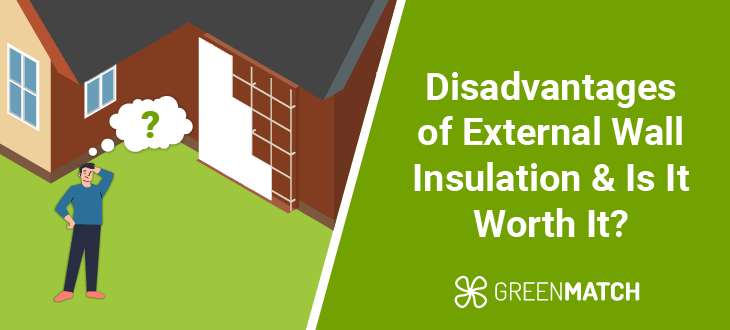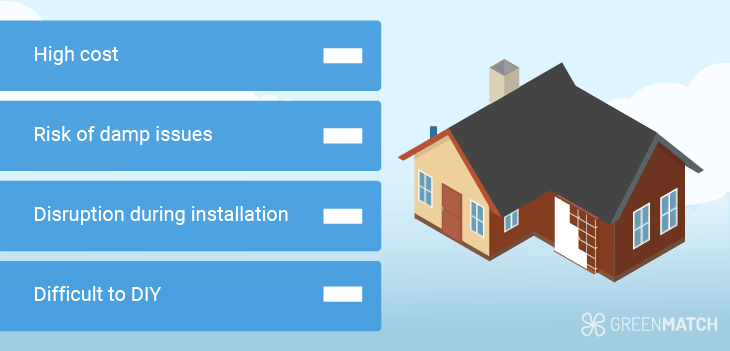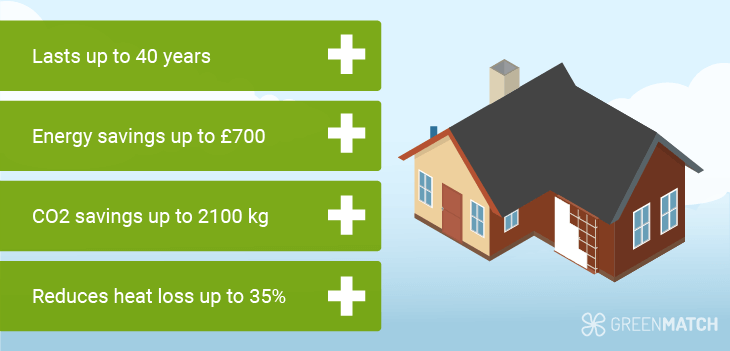Answer these simple questions and we will find you the BEST prices
Which type of solar quotes do you need?
It only takes 30 seconds
100% free with no obligation

Get Free quotes from insulation specialists near you

Save money by comparing quotes and choosing the most competitive offer

The service is 100% free and with no obligation
- GreenMatch
- Insulation
- Wall Insulation
- External Wall Insulation
- External Wall Insulation Disadvantages
Disadvantages of External Wall Insulation & Is It Worth It?


- External wall insulation can reduce heat loss by up to 35%, saving you up to £700 annually and lowering your carbon footprint by 2,100 kg of CO2.
- The primary disadvantages of external wall insulation are the high initial costs, potential disruption during installation, and changes to your home's appearance.
- Grants such as the Great British Insulation Scheme can help offset the installation costs, making external wall insulation a more affordable option for homeowners.
External wall insulation is a powerful solution for reducing heat loss by up to 35% in homes with solid walls. This type of insulation enhances energy efficiency and helps you save up to £700 annually on energy bills and cut your carbon footprint by 2,100 kg of CO2, making it an environmentally friendly choice.
However, despite these benefits, weighing the potential disadvantages of external wall insulation before deciding is crucial. Though it improves comfort and lowers heating costs, consider higher upfront costs, installation disruptions, and exterior appearance changes. Being aware of these factors will help you decide whether external wall insulation is the right investment for your home.
Whether you choose external wall insulation or explore other options, comparing quotes from various insulation specialists to ensure you find the best rate and installer to meet your needs and budget is essential.
However, comparing quotes can be time-consuming, and results may not always be satisfactory. GreenMatch provides a faster solution—fill out our quick 30-second form, and we'll connect you with up to four free quotes from top insulation specialists in your area. Whether you're considering external wall, internal, or loft insulation, we'll help you find the best installers for your project. Click below to learn more!
- Describe your needs
- Get free quotes
- Choose the best offer
It only takes 30 seconds



Disadvantages of external wall insulation

There are several key disadvantages of external wall insulation that you should consider to make an informed decision that fits your needs and budget. The top disadvantages of external wall insulation are:
High initial cost
The main disadvantages of external wall insulation for many people is often the cost. On average, external insulation costs around £11,000 for a semi-detached three-bedroom home. This high upfront cost is due to the extensive labour, scaffolding, and the durable, weather-resistant materials required for the installation.
While external wall insulation can offer long-term savings on energy bills, the initial investment can be a barrier. This substantial cost makes it essential for you to weigh the benefits against the expense before proceeding.
Disruption during installation
One of the main disadvantages of external wall insulation is that the installation process causes disruption. Workers typically set up scaffolding, which obstructs access to parts of your home and interferes with your daily activities. The installation process can last up to 10 days.
However, depending on the size of your property, it may take longer, resulting in noise, dust, and limited movement around the house. Additionally, weather conditions will delay the project, further prolonging the disruption.
Homes with external features like pipes, vents, or decorative elements may require temporary removal or relocation, increasing the inconvenience. Homeowners should expect significant disturbance during the installation of external wall insulation.
Exterior changes
One of the notable disadvantages of external wall insulation is the potential changes it makes to your home’s exterior appearance. Applying insulation outside the property involves adding insulating material, followed by a finish such as render or cladding.
This change can alter your home's look, which may not appeal to those who prefer the original style. Homes in conservation areas or listed buildings may require planning permission, adding complexity to the external insulation process. However, external wall insulation can improve your home's appearance, especially if the walls are weathered or in poor condition.
Reduction of external space
A lesser-known disadvantage of external wall insulation is the reduction of external space. The insulation process adds a layer of insulating material to the outside of the building, which can increase the overall thickness of the walls. It is recommended that the external wall insulation thickness should be between 50mm to 100mm.
The added bulk can reduce external space, especially in properties with narrow passageways, garden areas, or closely spaced homes. The added thickness can affect downpipes, window sills, and gutters, requiring them to be extended or adjusted. For homes with limited outdoor space or strict boundaries, reduced external space can be a drawback of external wall insulation.
Risk of damp issues
One significant disadvantage of external wall insulation is that improper installation can lead to damp issues. Damp problems can arise when condensation from your home cannot escape through the walls due to insulation blocking it. Ensuring proper ventilation is crucial to prevent moisture from becoming trapped between the insulation and the exterior wall.
Condensation can build up without adequate ventilation, leading to dampness, mould growth, and structural damage. Moreover, if the insulation materials or finishes are not adequately sealed or weatherproofed, water ingress from rain or snow can exacerbate the situation. These damp issues can result in costly repairs and negate the insulation's energy-saving benefits, so hiring skilled external wall insulation installers for the job is essential.
Potential damage to external features
One disadvantage of external wall insulation is the potential damage to existing external features of your home. Installing insulation requires adding a thick layer of material to the outside of the building, which may interfere with features such as gutters, downpipes, vents, window sills, and decorative architectural elements.
These features may need to be moved, extended, or even replaced to accommodate the insulation, increasing the overall complexity and cost of the project. Improper handling during installation can also damage or weaken these features, resulting in additional repair expenses. This can be particularly concerning for homes with unique or historic architectural details, as the modifications may alter the original charm or require specialist repairs.
Added weight to home’s structure
One of the less obvious disadvantages of external wall insulation is its added weight on your home’s structure. The insulation materials, combined with the protective layers like insulation render or cladding, can significantly increase the load on the building.
This additional weight may strain the foundation or walls of older or structurally weak homes, leading to potential issues such as cracks or structural instability over time. In some cases, homes may require reinforcement before external insulation can be installed, which adds to the complexity and cost of the project. Assessing your home’s structural integrity before opting for external wall insulation is essential to avoid potential long-term damage.
Planning Permission and building incompatibility issues
One of the key disadvantages of external wall insulation is the potential need for planning permission and its incompatibility with specific buildings. Homes in conservation areas, listed buildings, or properties with unique architectural styles often need planning approval before making any external modifications.
This can complicate the process and add time, cost, and potential hurdles to the project. In some cases, the installation of external insulation may not be permitted at all, particularly if the changes significantly alter the building’s appearance or historical value.
Incompatible for DIY
One problem with external wall insulation is that DIY external wall insulation is not possible. The process is complex and requires high expertise to ensure proper application. Installing external wall insulation requires careful preparation, including managing ventilation, weatherproofing, and securely fixing the insulation to the building's exterior.
Mistakes during installation, such as gaps in the insulation or improper sealing, can lead to issues like thermal bridging, dampness, or structural damage over time. Additionally, the materials used can be heavy and require specialised tools, making it difficult for untrained individuals to handle.
DIY external wall insulation isn't recommended; professional installation ensures quality but increases costs and limits homeowners' cost-cutting options.
Is external wall insulation worth it?

External wall insulation is a worthwhile investment because of its long-term environmental and financial benefits. Although it involves a higher initial cost, there are opportunities to receive free external wall insulation through grants such as the Great British Insulation Scheme, which can substantially lower the overall expense. These grants offset installation costs, allowing homeowners to improve their home's energy efficiency without significant financial strains
External wall insulation also helps reduce your home's carbon footprint by lowering the energy required to heat your property. As a result, it leads to fewer CO2 emissions, enabling homeowners to contribute to a greener future. Financially, external wall insulation can result in up to 35% heat loss reduction, leading to significant annual energy savings.
| Property type | Annual energy savings | CO2 savings |
|---|---|---|
| Apartment | £140 to £190 | 410 to 570 kg |
| Terrace house | £170 to £240 | 500 to 710 kg |
| Semi-detached house | £290 to £405 | 900 to 1,200 kg |
| Detached house | £500 to £700 | 1,500 to 2,100 kg |
External house insulation saves money and reduces the environmental impact on your household. Improving your home's thermal efficiency lowers energy consumption, reducing CO2 emissions and creating a more eco-friendly living space.
External wall insulation lasts up to 40 years, making it a long-term investment that pays off over time. Its durability makes the upfront cost manageable, as no replacement is needed for decades, adding value to your home.
Now that you understand the benefits, it's time to take action. Don't let high energy bills and heat loss affect your comfort. Fill out our quick 30-second form, and we'll connect you with up to four free quotes from top insulation specialists. Click below to learn more!
- Describe your needs
- Get free quotes
- Choose the best offer
It only takes 30 seconds



FAQ
Yes, external wall insulation can cause damp if not properly installed, as poor ventilation or inadequate sealing can trap moisture within the walls.
External wall insulation can last up to 40 years when properly installed and maintained.
Yes, insulating external walls is worth it for long-term energy savings, reduced carbon emissions, and improved home comfort, especially with available grants to offset costs.

Caoimhe is an experienced content writer and researcher who is passionate about providing accessible information to every reader. With a background in English literature and Sociology, she combines the two disciplines to create cohesive, well-thought-out, and well-informed pieces.
We strive to connect our customers with the right product and supplier. Would you like to be part of GreenMatch?

